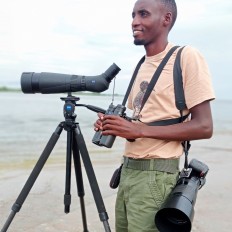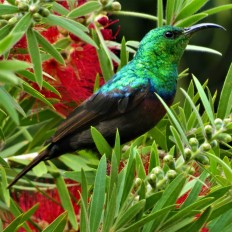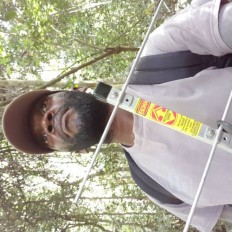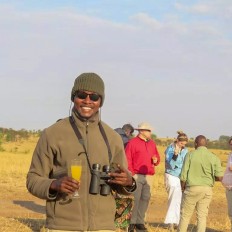Top species
- Knob-billed Duck (Sarkidiornis melanotos)
- African Black Duck (Anas sparsa)
- Purple-crested Turaco (Gallirex porphyreolophus)
- Bare-faced Go-away-bird (Crinifer personatus)
- Fiery-necked Nightjar (Caprimulgus pectoralis)
- Freckled Nightjar (Caprimulgus tristigma)
- Gray Crowned-Crane (Balearica regulorum)
- White-crowned Lapwing (Vanellus albiceps)
- Small Buttonquail (Turnix sylvaticus)
- Black-winged Kite (Elanus caeruleus)
- White-backed Vulture (Gyps africanus)
- Long-crested Eagle (Lophaetus occipitalis)
- African Scops-Owl (Otus senegalensis)
- Southern Ground-Hornbill (Bucorvus leadbeateri)
- Crowned Hornbill (Lophoceros alboterminatus)
- Pale-billed Hornbill (Lophoceros pallidirostris)
- Tanzanian Red-billed Hornbill (Tockus ruahae)
- Gray Kestrel (Falco ardosiaceus)
- Red-bellied Parrot (Poicephalus rufiventris)
- White Helmetshrike (Prionops plumatus)
- Ashy Starling (Lamprotornis unicolor)
- Arnot's Chat (Myrmecocichla arnotti)
- Western Violet-backed Sunbird (Anthreptes longuemarei)
- Beautiful Sunbird (Cinnyris pulchellus)
- Shelley's Sunbird (Cinnyris shelleyi)
- Southern Cordonbleu (Uraeginthus angolensis)
List up to ca. 25 species that:
• have a limited distribution range and/or are rare on a global level
• are most sought-after by birdwatchers at this site
• and are relatively easy to see at this site (year-round or seasonally)
| Knob-billed Duck (Sarkidiornis melanotos) | |
| African Black Duck (Anas sparsa) | |
| Purple-crested Turaco (Gallirex porphyreolophus) | |
| Bare-faced Go-away-bird (Crinifer personatus) | |
| Fiery-necked Nightjar (Caprimulgus pectoralis) | |
| Freckled Nightjar (Caprimulgus tristigma) | |
| Gray Crowned-Crane (Balearica regulorum) | |
| White-crowned Lapwing (Vanellus albiceps) | |
| Small Buttonquail (Turnix sylvaticus) | |
| Black-winged Kite (Elanus caeruleus) | |
| White-backed Vulture (Gyps africanus) | |
| Long-crested Eagle (Lophaetus occipitalis) | |
| African Scops-Owl (Otus senegalensis) | |
| Southern Ground-Hornbill (Bucorvus leadbeateri) | |
| Crowned Hornbill (Lophoceros alboterminatus) | |
| Pale-billed Hornbill (Lophoceros pallidirostris) | |
| Tanzanian Red-billed Hornbill (Tockus ruahae) | |
| Gray Kestrel (Falco ardosiaceus) | |
| Red-bellied Parrot (Poicephalus rufiventris) | |
| White Helmetshrike (Prionops plumatus) | |
| Ashy Starling (Lamprotornis unicolor) | |
| Arnot's Chat (Myrmecocichla arnotti) | |
| Western Violet-backed Sunbird (Anthreptes longuemarei) | |
| Beautiful Sunbird (Cinnyris pulchellus) | |
| Shelley's Sunbird (Cinnyris shelleyi) | |
| Southern Cordonbleu (Uraeginthus angolensis) |
White-backed Vulture (Gyps africanus) was added by Isaac Kilusu (2021-08-02 15:16:09)
Bare-faced Go-away-bird (Crinifer personatus) was added by Isaac Kilusu (2021-08-02 15:15:06)
Western Violet-backed Sunbird (Anthreptes longuemarei) was added by Isaac Kilusu (2021-08-02 15:14:07)
Arnot's Chat (Myrmecocichla arnotti) was added by Isaac Kilusu (2021-08-02 15:13:27)
Tanzanian Red-billed Hornbill (Tockus ruahae) was added by Isaac Kilusu (2021-08-02 15:13:15)
Pale-billed Hornbill (Lophoceros pallidirostris) was added by Isaac Kilusu (2021-08-02 15:12:55)
Ashy Starling (Lamprotornis unicolor) was added by Isaac Kilusu (2021-08-02 15:12:34)
Small Buttonquail (Turnix sylvaticus) was added by Isaac Kilusu (2021-08-02 15:12:00)
Black-winged Kite (Elanus caeruleus) was added by Isaac Kilusu (2021-08-02 15:10:39)
Gray Crowned-Crane (Balearica regulorum) was added by Isaac Kilusu (2021-08-02 15:10:24)
Gray Kestrel (Falco ardosiaceus) was added by Isaac Kilusu (2021-08-02 15:09:46)
Red-bellied Parrot (Poicephalus rufiventris) was added by Isaac Kilusu (2021-08-02 15:09:03)
Crowned Hornbill (Lophoceros alboterminatus) was added by Isaac Kilusu (2021-08-02 15:06:59)
Long-crested Eagle (Lophaetus occipitalis) was added by Isaac Kilusu (2021-08-02 15:06:41)
White-crowned Lapwing (Vanellus albiceps) was added by Isaac Kilusu (2021-08-02 15:05:22)
Southern Ground-Hornbill (Bucorvus leadbeateri) was added by Isaac Kilusu (2021-08-02 15:03:55)
Purple-crested Turaco (Gallirex porphyreolophus) was added by Isaac Kilusu (2021-08-02 15:03:25)
Knob-billed Duck (Sarkidiornis melanotos) was added by Isaac Kilusu (2021-08-02 15:02:53)
African Black Duck (Anas sparsa) was added by Isaac Kilusu (2021-08-02 15:02:35)
White Helmetshrike (Prionops plumatus) was added by Isaac Kilusu (2021-08-02 15:01:52)
Southern Cordonbleu (Uraeginthus angolensis) was added by Isaac Kilusu (2021-08-02 15:01:08)
African Scops-Owl (Otus senegalensis) was added by Isaac Kilusu (2021-08-02 15:00:02)
Shelley's Sunbird (Cinnyris shelleyi) was added by Isaac Kilusu (2021-08-02 14:58:55)
Beautiful Sunbird (Cinnyris pulchellus) was added by Isaac Kilusu (2021-08-02 14:58:23)
Fiery-necked Nightjar (Caprimulgus pectoralis) was added by Isaac Kilusu (2021-08-02 14:56:27)
Freckled Nightjar (Caprimulgus tristigma) was added by Isaac Kilusu (2021-08-02 14:55:43)





